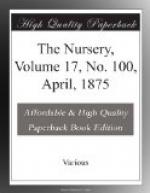[Footnote A: Robert Southey, an English poet, wrote these lines, not for our “Nursery,” but for all nurseries where children are gathered and taught. The Cataract of Lodore is near Keswick, Cumberland County, England. Robert Southey died in the year 1813.]
BOILING MAPLE-SUGAR.
Most of the sugar we use is made from the sugar-cane, which grows in warm countries. But in France they make a good deal of sugar from beets; and in North America, where the sugar-maple-tree grows, some very nice sugar is made from its sap.
Early in spring, while the weather is yet cold, and before the trees have begun to show many signs of life, it is the time for tapping the maples.
The sun, which has already begun to make his power felt by melting the snow, and leaving great green patches here and there on the cleared lands, has kissed the rugged trunks of the trees, and has set the sweet sap mounting through every vein and tissue.
Now is the time to set the troughs in order, and to bore the holes for the little spouts through which the juice must run. These must be made a foot from the ground, on the sunny side of the tree; and very soon the drip, drip, of the oozing sap will be heard, as it trickles over the spout into the rough bowls placed to catch it at the foot of every maple.
As each trough fills, the juice is poured, first into a large barrel, and from thence, when all is ready, into the great iron pot, or caldron, slung over the wood-fire on three poles.
In the picture, you may see three brothers, with their two sisters, engaged in collecting the sap, and boiling it till it can be cooled as sugar. If you will look sharp, you can see little bowls placed at the root of some of the trees, and the sap flowing into them.
A syrup is made from the sap, which is very delicate, and is much used for buckwheat-cakes. A large quantity of maple-sugar is made every year in the northern part of the United States, and in Canada. But it cannot be made so as to compete with the sugar of the sugar-cane in cheapness.
UNCLE CHARLES.
THE STOLEN BIRD’S-NEST.
Once there were two little sparrows who built for themselves a nest on a small tree by the wayside. The mother-bird laid four little eggs in it; and there she sat, while her mate chirped merrily on a tree near by, till, one fine day in May, four little sparrows were hatched.
How glad the parent-birds were! and how they flew round to get food for their little ones! They were willing almost to starve themselves, so that their children might not suffer from want.
Oh, what hungry children they were! How they would stretch out their necks, and open their bills for food, as father and mother drew near to feed them! And what queer little noises they would make, as if they were saying, “Feed me first! Oh, give me that nice little worm! No, I am the hungriest, give it to me! Me first! Me first!”




